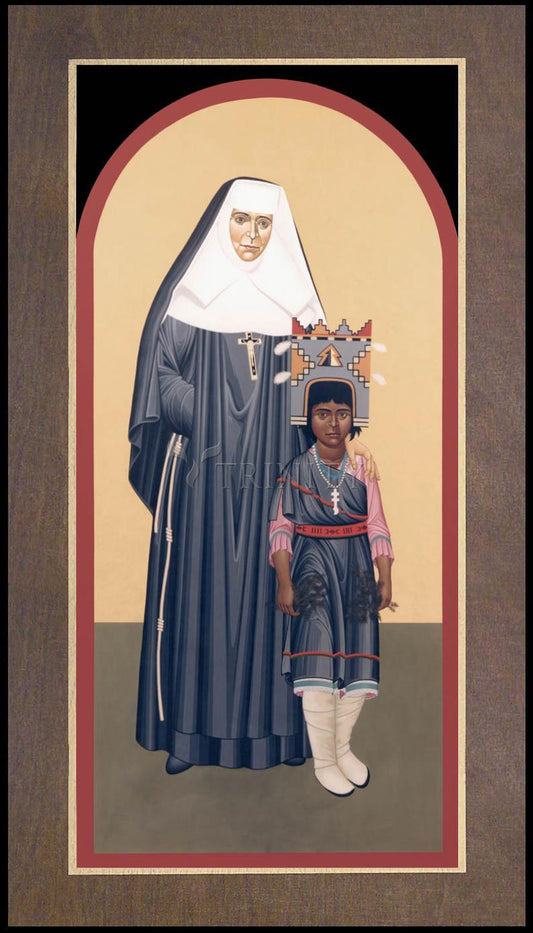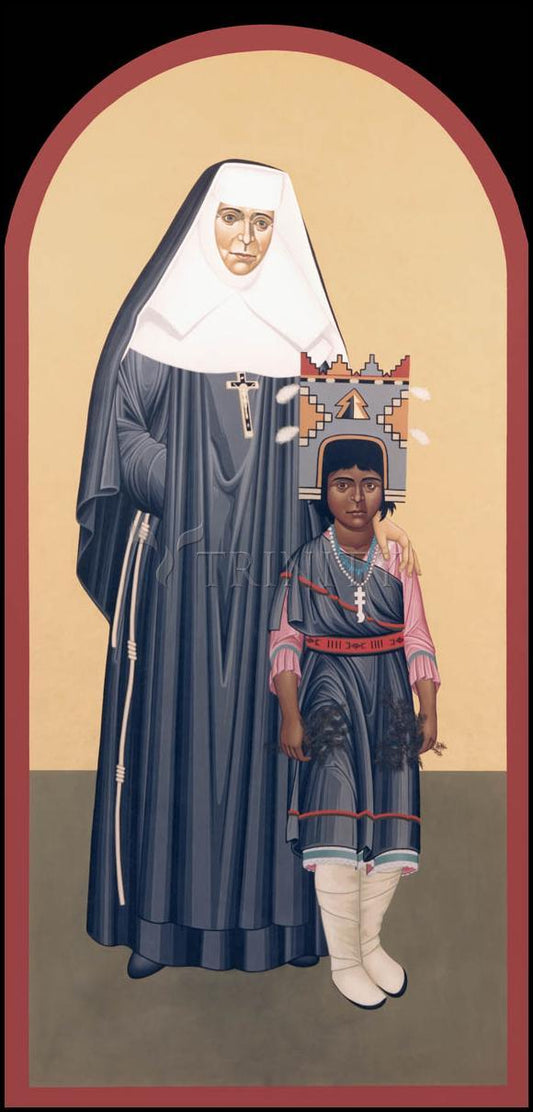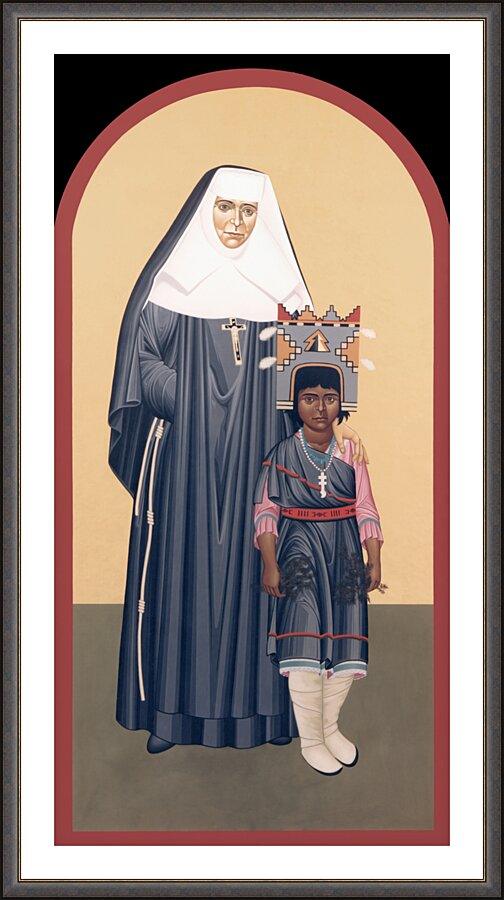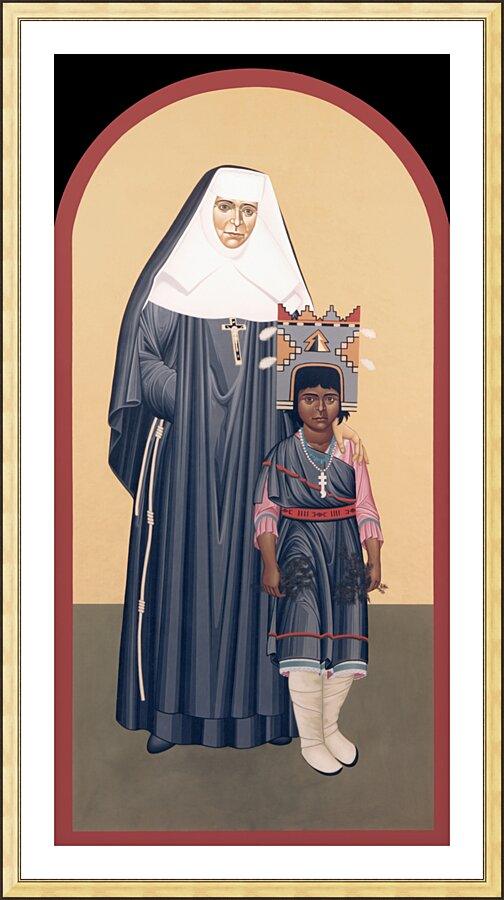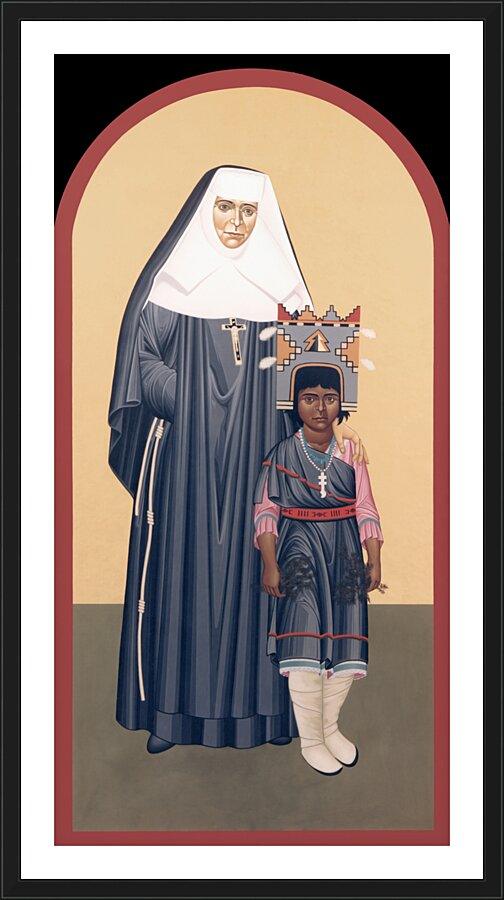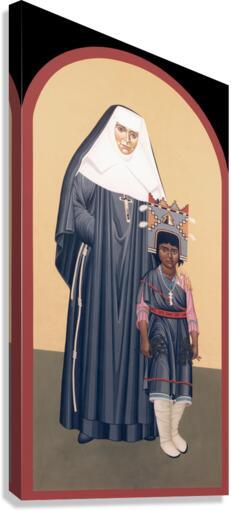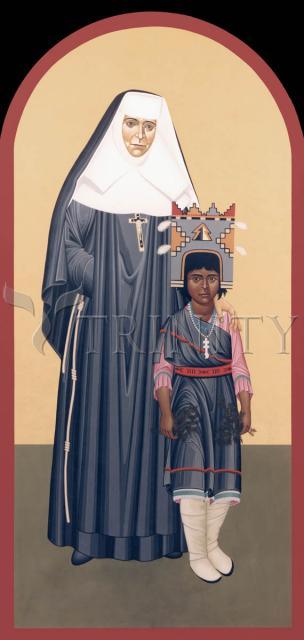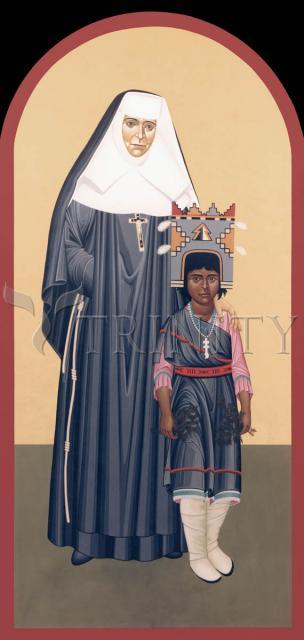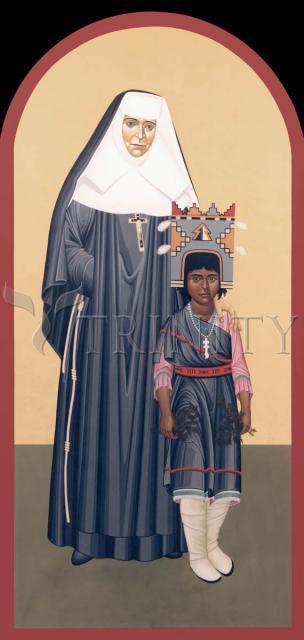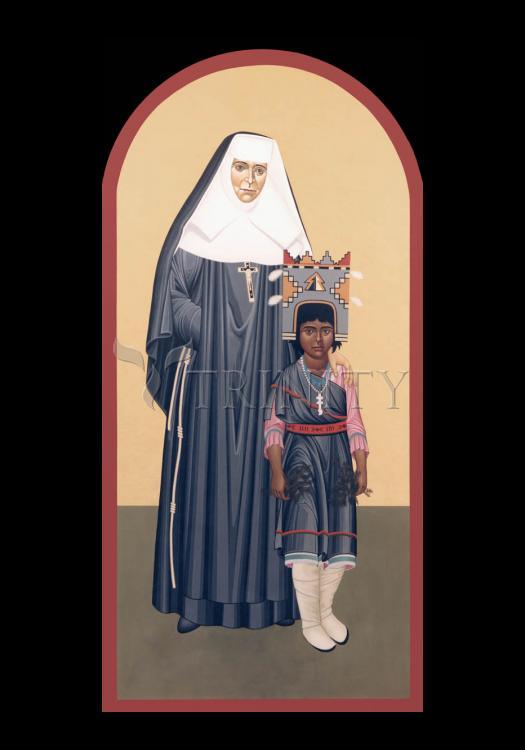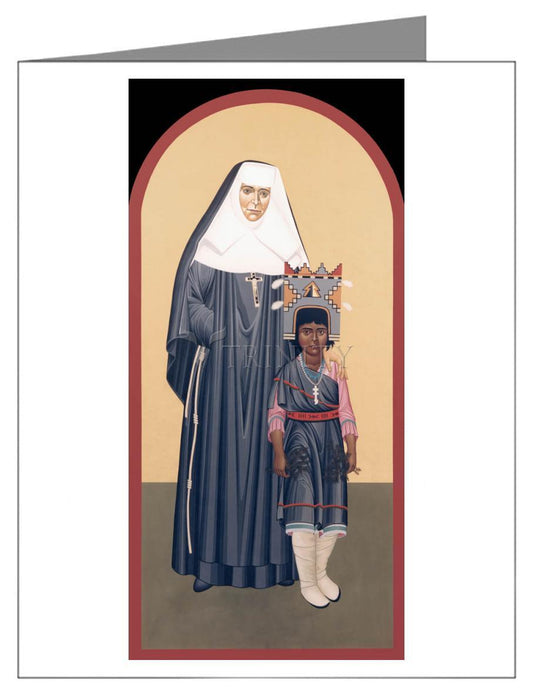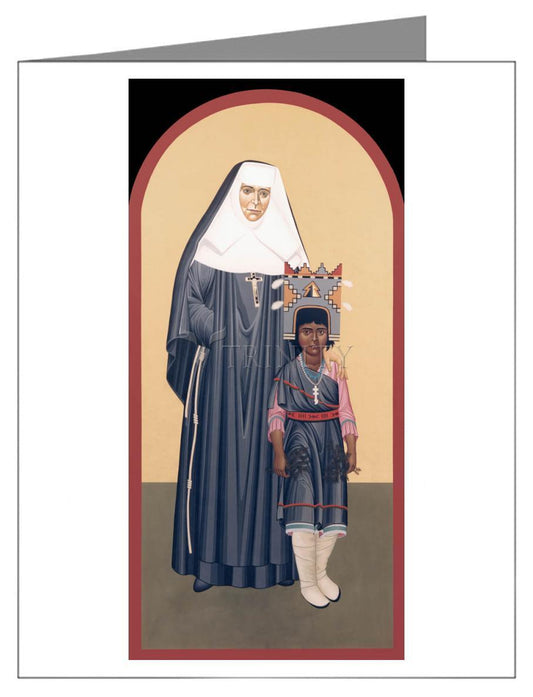On October 1, 2000, Pope John Paul II solemnly decreed that Katharine Drexel, Founder of the Sisters of the Blessed Sacrament for Indians and Colored People, is a saint of the Catholic Church. A third-generation, thoroughly "Red-blooded" American had been added to the rolls of the canonized saints.
First, let us briefly summarize the significant events in the life of our saint. Katharine Drexel, the second of three sisters, Elizabeth, Katharine and Louise, was born in 1858. Her father, Francis, was a Catholic; her natural mother, Hannah Langsroth Drexel, a Baptist Quaker, died soon after giving birth to Katharine. Two years later, her father married a Catholic, Emma Bouvier, who gave birth to a third daughter, Louise, in 1863. In 1887, in a private audience with Pope Leo XIII, Katharine pleaded for priests to serve the American Indians. His fateful reply was that she, herself, should become that missionary. At the end of 1888, at the age of thirty, she received permission from her spiritual director to become a religious and joined the Sisters of Mercy for her training. In 1891, she founded the Sisters of the Blessed Sacrament for Indians and Negroes. (Intending to extend the focus of her order, she later changed the word "Negroes" to "Colored People.") The order grew to include sixty schools and missions while the Sisters of the Blessed Sacrament eventually numbered more than five hundred. In 1935, when she was seventy-seven years old, St. Katharine suffered a severe heart attack and until her death in 1955 lived in prayerful retirement. Her cause was opened in 1964 and in 2000 Pope John Paul II canonized her.
A Privileged American Catholic Childhood
If anyone could be described as having been "born with a golden spoon in her mouth," it would have been Katharine Drexel and her sisters, Elizabeth and Louise. Few American girls would have had more of an excuse to be distracted by the world and what it has to offer than these daughters of one of the most prominent and wealthy families in the United States. Their father, Francis Drexel, was an outstanding banker and exchange broker " a founding partner in what was known at the time as Drexel, Morgan and Company.
Francis Drexel and his second wife, Emma (Bouvier), were more than devout Catholics. They were determined to instill truly Catholic teachings and norms of behavior into their children. They understood the principle, later summed up by the great Fr. Leonard Feeney, that "Catholicism is a manner." Thus, from an early age, Emma trained her daughters in the dispensing of alms and performing other works of Catholic Charity. She had the charitable heart of a great Catholic woman who wanted her children to capture the spirit of true Catholic Charity and learn how to give alms prudently " in sharp contrast to other wealthy Americans of the day who engaged in self-serving, pompous philanthropy.
Convinced that a proper education and formation are essential ingredients of a Catholic manner, Francis and Emma retained two devout Catholic women, both of whom would have a major influence on the Drexel girls. Johanna Ryan, their trusted servant, was from Ireland, where she had tried to become a Sister of the Sacred Heart but was unable to continue because of her health. Although a simple person, she was unflinching in her defense of the Faith and taught the girls of the necessity of the Catholic Faith in order for one to be saved. The absolute sincerity of Johanna's faith was somewhat indecorously demonstrated during an audience with Pope Pius IX in 1875. After the family had visited a few moments with the Holy Father, she fell to the floor, threw her arms around his knees and exclaimed, "Holy Father " praise God and His Blessed Mother " my eyes have seen our dear Lord, Himself!"
A more reserved Miss Mary Cassidy, the governess, was also from Ireland. The Drexels hired her after a careful search for someone that was not only a devout Catholic but had a deep and broad education with emphasis on literature and philosophy. As part of Miss Cassidy's tutoring program for the girls, she required regular compositions and lengthy letters while the family traveled. Katharine remained a prodigious letter writer for the rest of her life. We know a great deal about her intellectual, emotional and spiritual development from the thousands of her letters, memos and personal notes that have been preserved in the archives of the Sisters of the Blessed Sacrament.
Several qualities of Katharine's life are indicative of the road to sanctity she was to follow. The first was her intense love of the Blessed Sacrament which manifested itself when she was a little girl as a fervent desire to make her First Holy Communion. In a letter to her mother, written in 1867, she said, "Dear Mama, I am going to make my First Communion and you will see how I will try to be good. Let me make it in May, the most beautiful of all the months."
Katharine's love for Our Lord in the Blessed Sacrament was to grow in intensity throughout her life. After she formed her order, she took great pleasure in building a tabernacle in a location where the Blessed Sacrament had never been adored before. Often, at night, long after everyone else had retired for the evening, the sacristan would find her in the darkened church, kneeling with arms outstretched in front of the Blessed Sacrament or the Crucifix. Her concentration was so intense that she remained completely unaware that she was being observed. Throughout her life she meditated before and upon Jesus present in the Tabernacle and recorded many of her reflections and prayers. One of her later notes reads as follows:
"Ah, Lord, it is but too true, YOU ARE NOT LOVED! Shall we not strive by every means in our power to make you known and loved? Shall we not try to pay many an extra visit to our dearest Friend, ever present in the Blessed Sacrament, ever living to make intercession for us? And may this prayer, dearest Lord, be on our lips when we bow down in lowly adoration in your sacramental presence: 'Sacred Heart of Jesus, you love! O Sacred Heart of Jesus, you are not loved! O would that you were loved!' Our Lady, open your heart to me, your child. Teach me to know your Son intimately, to love him ardently, and to follow him closely."
The salvation of souls, especially those souls that were the most neglected and forgotten, was the great quest of St. Katharine. Even as a little girl, she and her sisters knew that only Catholics are saved. As may be expected in "pluralistic" America, this proper Catholic belief led to several embarrassing incidents for Mr. and Mrs. Drexel, who, although they were devout Catholics, appear to have been somewhat weak in this area. As mentioned earlier, St. Katharine's natural mother, Hanna Langsroth, as well as her grandparents, Piscator and Eliza Langsroth, were Protestants. One day, during a visit at the Langsroth's, Katharine's older sister, Elizabeth, said to her grandmother, "Oh, Grandma, I am so sorry for you because you can never go to heaven."
"And, why cannot Grandmother go to heaven?" Mrs. Langsroth asked.
With the simplicity and purity of a truly Catholic child, Elizabeth replied, "You are a Protestant and Protestants never go to heaven."
On another occasion, a friend of Grandma Langsroth's, a Protestant minister, was visiting at the same time as were Elizabeth and Katharine. As the girls relayed the story in later years, when Mrs. Langsroth asked the minister to say grace before the meal, it caused them to go into a kind of panic. The girls decided to hold up their rosaries in full view during the meal prayer as a clear statement of their Catholicism. It appears that their feistiness for the Faith was more the result of the instruction of Johanna, the family servant and staunch Irish Catholic, than of the direct influence of Mr. and Mrs. Drexel. In fact, both of these early defenses of the faith caused some embarrassment for Francis and Emma. Sadly, they decided to smooth the ruffled feathers of the errant grandmother rather than support the innocent defense of the Faith provided by their children.
Despite this weakness in the belief of their parents, the Drexel daughters recognized the necessity of sacramental Baptism for salvation. When the oldest sister, Elizabeth, was married and in danger of losing a baby, she wrote to Katharine, "My pious and good little religious sister, Katharine, we count on your prayer to bring ours safely to the waters of Baptism and beyond them through a good and useful life to Heaven." Later Mother Katharine would record this plea to the Mother of God, "O Mary, make me endeavor, by all the means in my power, to extend the kingdom of your Divine Son and offer incessantly my prayers for the conversion of those who are yet in darkness or estranged from His fold."
Born: November 26, 1858 at Philadelphia, Pennsylvania, USA
Died: March 3, 1955 of natural causes at the motherhouse of the Sisters of the Blessed Sacrament, Bristol Pike, Bensalem, Pennsylvania
Beatified: November 20, 1988 by Pope John Paul II
Canonized: October 1, 2000 at Rome by Pope John Paul II
Also known as: Catherine Marie Drexel



